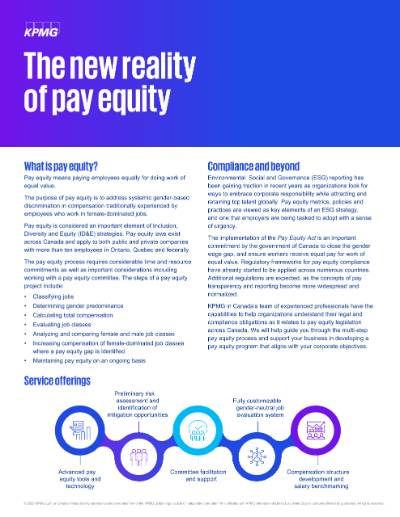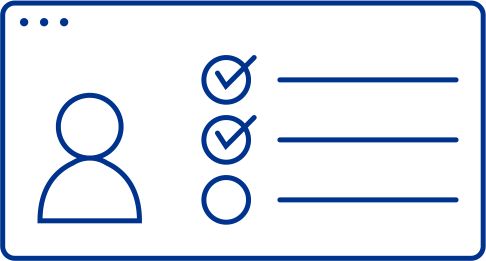Service offerings | KPMG’s pay equity process | Pay equity tools | How KPMG Can help
Pay equity metrics, policies and practices are viewed as key elements of an ESG strategy, and one that employers are being tasked to adopt with a sense of urgency.
The implementation of the Pay Equity Act is an important commitment by the Government of Canada to close the gender wage gap and help ensure workers receive equal pay for work of equal value. This commitment is echoed through various provincial legislations being implemented across British Columbia, Ontario and Quebec. Additional regulations are expected, as the concept of pay reporting becomes more widespread and normalized.
The Canadian Pay Equity legislation stipulates that all Canadian employers subject to the Act must post a final pay equity plan by September 3, 2024.
KPMG in Canada’s team of experienced professionals have the capabilities to help organizations understand their legal and compliance obligations as it relates to Canadian Pay Equity legislation, at both the federal and provincial levels. We can help guide you through the multi-step pay equity process with the help of KPMG’s proprietary pay equity tool to support your businesses in developing a pay equity strategy that aligns with corporate objectives to support and enable your workforce.
KPMG’s pay equity process
Ensuring your organization is paying women and men equally for doing work of equal value is crucial and allows you to correct systemic gender-based discrimination in compensation. Our KPMG advisors can walk you through a step-by-step plan to ensure you are carrying out the requirements laid out in the federal Pay Equity act.
While pay equity is a legal requirement for many employers, it’s also the right thing to do for your employees. At KPMG, we utilize leading-edge technology to help you navigate the complex path to compliance.

While KPMG offers a full-service end-to-end pay equity process, our advisors can work with you to develop a customized pay equity strategy for your unique organizational needs.
Pay equity tools
At KPMG, we believe in the power of technology to drive change. Our team of experienced professionals have developed innovative tools to help you understand and meet your pay equity compliance obligations. Our tools are designed to be efficient, scalable, and customizable, ensuring that they can be tailored to meet the unique needs of your organization.
How KPMG can help
KPMG's team of multidisciplinary professionals can help your organization in developing a pay equity program that supports and enables your workforce.
While we offer a full-service approach to developing a pay equity strategy, our advisors can work shoulder to shoulder with you to develop a customizable approach no matter where you are in the pay equity process. Contact us today to Understand your legal and compliance obligations relating to pay equity legislation across Canada and build a strategy that aligns to your corporate objectives.
Insights and resources
Connect with us
Stay up to date with what matters to you
Gain access to personalized content based on your interests by signing up today
Connect with us
- Find office locations kpmg.findOfficeLocations
- kpmg.emailUs
- Social media @ KPMG kpmg.socialMedia










